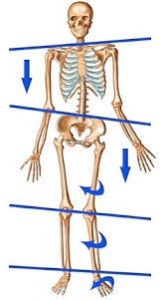News & Advice
So…You Thought You Had Back Pain?
Call 01282 453 110 to book your appointment.
Pelvis issues account for a large proportion of failed treatments for low back pain because the pain seems to come from the lumbar (low back) region but it’s actually because your spine is sat on a wonky pelvis!!
In fact as you can see from the picture a ‘wonky’ pelvis can also account for pains and damage in many other areas like the hip, knee, upper back and even the neck!
The most common area a malaligned pelvis effects however is its closest neighbour…the lower back.
Think of your pelvis like the foundations that your house sits on. If the foundations are askew so will be the rest of your ‘house’. Unlike your house however the human body adapts all the way up to your head because an out of position pelvis causes the spine to bend to one side. Technically this should mean the whole body leans to one side but because of our vision we correct the head position (so that we can see straight!) and this creates a series of curves from left to right.
The pelvis consists of 3 bones liked at the front by 1 joint and the back at 2 Sacroiliac joints. The pelvic bones can be ‘stuck out of position’ in many directions (rotated forward or back, slid up or down, or even side bent to left or right). It can be very hard visually to see this as the movements can be as small as millimetres and body shape can hide a multitude of sins.
The pelvic joints (Sacroiliac) can produce pain (very low back, in the ‘dimples’ of your back) but its very common for the curved spine above to give pain in the joints or disc as the strain from life flows abnormally excessively through these much smaller joints than the pelvis. As you can imagine this can then cause injury that can be constant or produce intermittent flare ups through no apparent cause.
There are a few common causes of pelvis malalignment:
1. Trauma (fall or direct impact) – like falling twisted, hitting the ground hard, a rapid pull on leg
2. Abnormal resisting following childbirth – the pelvis moves to allow birth and as it relaxes back doesn’t quite sit back into its correct position. This can also occur during pregnancy too
3. One leg being longer than the other – surprisingly common this one and anyone whose has tailored trousers may have been told this (lucky them )
4. Flat feet – especially if one is particularly bad. Effectively this lowers the arch, shortens the leg, and twists the hip inward. Lots of abnormal forces!
So, “that’s all great”, you say, but how can I sort it out…well it’s fairly easy.
Find out if the pelvis is ‘out’ – a physio can tell you this
Find out WHY the pelvis is out – so we can stop it going out again
Realign the pelvis – a physio will use manipulatory techniques to do this
Help and areas recover that have had excess strain – commonly this means releasing muscles or joints
Strengthen everything back up in a symmetrical fashion – this can be as easy as going for a walk
For more information on Pelvis conditions you can use our ‘Ask-A-Physio‘ service or book an appointment by contacting us on 01282 453 110. Otherwise, keep your eyes peeled over the next few months for further articles on pelvises.